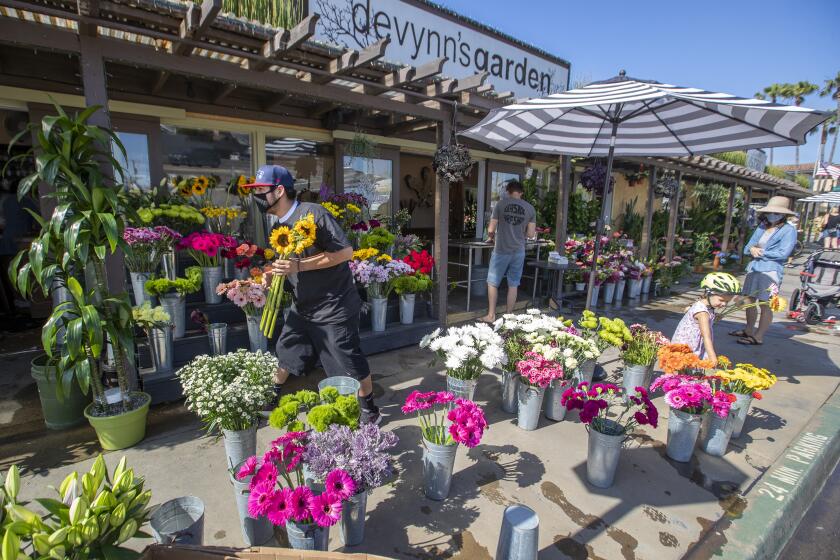Its theater went dark, but Segerstrom Center remains active online for students and the public
- Share via
Hands out, bent knees and slowly circling hips are the basic moves Stephan Seanoa uses to start the first five minutes of his dance cardio class.
Seanoa, co-founder of Santa Ana-based Tupua Productions, led virtual classes featuring Polynesian, Tahitian and Island dance for the Segerstrom Center for the Arts. The last session was on Tuesday, but the 15- to 20-minute videos remain available for viewing on Segerstrom’s web page dedicated to a variety of classes from storytelling and ballet to making your own marionette doll.
Live performances were among the first to be affected by COVID-19, and they will be the last to recover.
In mid-March, Segerstrom and its resident artists were forced to abandon their 2,000- and 3,000-seat halls. The center is Orange County’s largest nonprofit arts organization that hosts major tours of music, theater and dance. Performances scheduled at the center through the end of the year have been cancelled or rescheduled to summer and fall of 2021.
So far, 70% of ticket holders have requested a refund, 26% asked for a gift certificate or to swap the ticket for a future performance, and 4% donated the purchase price to the center.
“We’re doing pretty well considering circumstances,” said center President Casey Reitz. “We’ve had a very strong history of solid financial management. I think we’re well positioned to deal with this. That said, our ticket sales comprise typically about 75% of our budget. When you can’t sell tickets, you shrink your budget.”
Email david.carrillo@latimes.com to sign up for the newsletter featuring the latest news involving Newport Beach, Huntington Beach, Costa Mesa, Laguna Beach, Fountain Valley and other parts of Orange County.
Reitz added the rest of the center’s finances rely on contributions from foundations, individual support and fundraising events.
Segerstrom has avoided layoffs and is still compensating employees who can’t work remotely, such as ushers and ticket takers.Stocking up on virtual content
Staff who were able to work remotely helped switch over many scheduled classes, workshops and public events to online platforms.
First, teaching artists recorded classes and sent videos to students enrolled in the School of Dance and Music for Children with Disabilities and the American Ballet Theatre William J. Gillespie School.
“Whether they are dealing with down syndrome, cerebral palsy or autism, these classes are a huge boost for [the students’] well-being and their parents — having some help in taking care of their kids,” said Reitz.
Talena Mara, the center’s vice president of education, said Segerstrom serves 300,000 people in Orange County, San Bernardino County and San Diego through the education programs every year. The number includes interns, local teachers seeking professional development and incarcerated people.
“We knew that we would have schools and organizations that were going to depend on it for the programming that they already scheduled,” said Mara. “While students were doing schooling from home, they were still going to need to have resources available.”
In partnership with nonprofit Alzheimer’s Orange County, Segerstrom also provides movement and wellness activities for those who are living with Alzheimer’s and dementia.
“We can still take that same instructor and connect to them digitally and make sure that they’re getting the important wellness content that they need for self-care and to regulate themselves while they’re isolated in their vulnerable population,” said Jason Holland, vice president of community engagement. “We didn’t want to walk away from that.”
Classes, usually reserved for enrolled students, along with other community-based events like free Tuesday night dance at the plaza, are shared online with the public. The center’s educational and engagement teams are brainstorming how to turn festivals and showcases into immersive online events.
Their first experiment will premier May 17 with the Virtual Spring Carnival.Reopening plans
The concert industry could take well over a year or more to return to normal according to Gov. Gavin Newsom’s four-step plan for California’s economic and social life.
A Segerstrom task force is putting together protocols that align with county and state health and reopening guidelines.
“We’re working with a performing arts center coalition now to put together a report of best practices, so we can inform not just what’s best for the center but what’s best for a lot of arts organizations around the country,” said Reitz.
Newsom’s plan left enough room for interpretation. Reitz is one of the participating members of “reStore Costa Mesa,” a city-organized initiative that called on major business leaders in automobile, banking and finance, restaurants, hospitality and tourism to design a plan specific to Costa Mesa’s economy.
Reitz is still uncertain when and how Segerstrom will reopen but imagines the 14-acre campus could gradually come back. He sees the Julianne and George Argyros Plaza as a public space that could open up during the second phase. The Samueli Theater could open in stage three, and the other concert halls most likely fall under stage three and four.
In the meantime, the center continues to experiment with digital life — and so do local artists.
Without their usual corporate and private gigs, Seanoa’s Tupua Productions moved their family-run studio classes to Facebook. But nothing safely available on laptops compares to being in the room. Senano’s clientele, frustrated with spotty Wi-Fi and tech issues, is declining.
“We are crossing our fingers and just trying to figure out how we can stay alive during this crisis, ” said Seanoa.
The studio is taking requests for social-distancing Polynesian floor shows in the form of drive-by dances or graduation grams and continues to brainstorm how to move forward with dance.
All the latest on Orange County from Orange County.
Get our free TimesOC newsletter.
You may occasionally receive promotional content from the Daily Pilot.







